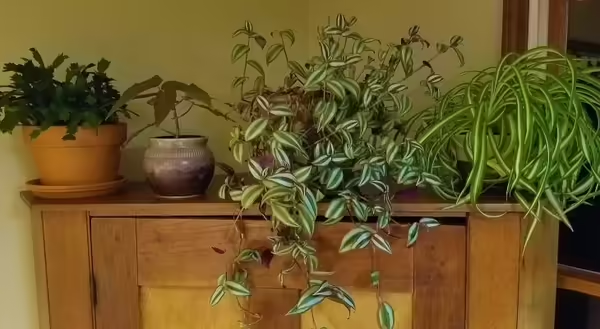
Winter is a stressful time for many plants in the landscape, given the drought conditions brought on by freezing temperatures and the effects of extreme cold.
Although these stressors typically don’t impact our houseplants the same way, indoor plants experience their own form of winter stress, making wintertime one of the most common times of year for the decline or death of houseplants.
Similar to outdoor plants, wintertime brings some challenges with water to our houseplants, although we can do a lot to reduce the impact by paying special attention. Surprisingly, more houseplants die during winter from over-watering rather than under-watering. It’s just not a time of high water demands since growth rates are reduced by dwindling sunlight and often lower indoor temperatures. When plants aren’t growing as much, water demands are much lower. Overwatering can lead to poor growth and serious root issues since persistent moisture allows root rotting fungi to become established.
Prepare houseplants for winter
Decrease watering
Most houseplants do best when soil is allowed to nearly dry out completely between watering. Since growth and water uptake are less in winter, it is really important to modify watering times accordingly. The best way to monitor soil moisture is by feel. Use your finger to feel the upper 1-2 inches of soil a few times a week in order to get dialed in. Only add water when you feel the soil has dried out and water thoroughly to ensure the entire pot is saturated.
If they are small enough, lift the pot up and test the weight each time you check soil moisture. For most of my houseplants, I can tell when they need water from their weight since the soil medium dries out so much. Pots often weigh half as much as they do when saturated.
Increase humidity
To compound the watering issue, indoor air is often very dry during winter with relative humidity sometimes plummeting below 20%. Since most houseplants prefer 40% to 50% humidity for normal healthy growth, low relative humidity brings on additional stress.
If you have a humidifier, move houseplants a little closer this time of year to boost humidity. Another very simple solution is to cluster your plants by placing them close together for winter. As they naturally release water by transpiring, the group will benefit from the microclimate they create. Kitchens and bathrooms often have higher humidity, making them great overwintering locations if they receive adequate light and you have the window space.
If moving plants isn’t an option, add a shallow tray of water below your plant to add humidity. Be sure to keep the pot up out of the water so the soil medium isn’t able to wick up moisture. Many folks place decorative rocks in a tray to boost pots up out of standing water.
The age-old practice of misting leaves is actually of negligible benefit given the relatively short humidity boost it provides unless you are misting constantly throughout the day. I didn’t realize this until I purchased a small, digital thermometer and humidity gauge. The effects from misting only lasted minutes compared to the constant slow release from a shallow tray.
How to help houseplants
Light
Light is perhaps the greatest factor limiting houseplant growth in winter. As days grow shorter and the sun dips lower on the winter horizon, the light reaching houseplants can vary dramatically. Pay attention to the sun’s angle to be sure your sunny, south-facing window still receives adequate light during winter. Some north-c and east-facing windows that were great indirect light during summer can become too shaded during winter. As shade trees lose their summer canopy, windows with filtered light during summer can become nearly full sun in winter. Be sure the light reaching houseplants isn’t changing more than you realize during winter.
Temperature
Dramatic swings in environmental conditions are incredibly difficult for plants and the indoor winter environment can often create huge daily fluctuations in temperature. Take care to be sure houseplants are away from drafts, cold windows, or heat vents. Most houseplants prefer a daytime temperature between 65° and 75° with only about a 10° drop at night. A digital thermometer placed near your plant can help track temperatures to ensure the daily fluctuations aren’t too extreme.
Research has identified a whole suite of health benefits provided by indoor plant life. So, houseplant care is important for both plant and human health. I often think of the indoor environment as more controlled than outdoors, making plant care easier. However, the changes to our indoor environment in winter are often very subtle and slow, requiring careful attention to avoid added stress on houseplants. This year, take note of light and moisture levels to better control the indoor winter environment for the benefit of all your indoor plant life.